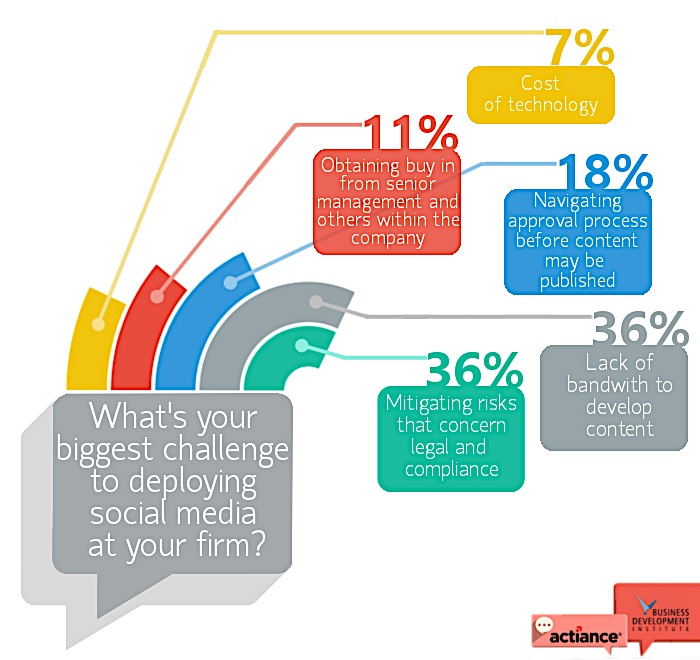
By: Joanna Belbey
 Recently, I participated with Lori Feldman, Global Head of Social Media, CIGNA on a webinar “Using Social Media in the age of ACA and HIPAA Regulations.”
Recently, I participated with Lori Feldman, Global Head of Social Media, CIGNA on a webinar “Using Social Media in the age of ACA and HIPAA Regulations.”
During the webinar, we polled the attendees to understand their concerns. Surprisingly, “Lack of Bandwidth to Develop Content” tied “Mitigating Risks That Concern Legal and Compliance” as the biggest challenges to deploying social media at their firms.
We have seen that a key component of being successful on social media is offering content that is useful and interesting to your followers while carefully aligning with the personality and culture of your business’s brand. But how do you do that exactly within a regulated industry?
Although content creation may seem overwhelming at first, there are some proven steps that you can take to get the ball rolling:
Collaborate
As part of the process of deploying social media at a business in a regulated industry, form a social media working group with the key stakeholders that will be impacted by social media. This may include, but, not be limited to HR, legal, compliance, risk, governance, investor relations, corporate communications, marketing, the lines of business and IT and security.
Ask For Help
Partner with your marketing or corporate communications team to define the type of content to interest your various targeted audiences. Then based on these conversations, illustrate for the social media working group the type of content that you plan to share. Most businesses start by creating an inventory of pre-existing content currently available on their websites and other content repositories that can be leveraged for social media. Be as specific as possible.
Gain Buy-In
An effective strategy to gain buy-in from senior management and your social media working group is to create the actual content that you plan to use for the first month. Include an editorial calendar, as well. This helps people who are not familiar with social media to visualize exactly what you are talking about. It also alleviates concerns that inappropriate content may damage the reputation of the firm expressed by legal, compliance and human relations. At first, some businesses elect to simply post the same content to all three social networks at the same time. However, that’s a lost opportunity. It is much more effective to version your content to reflect the subtle differences between the social media sites and their different audiences.
Make Content “Snackable”
As you are beginning to see, content creation isn’t as simple as throwing up a link to an existing whitepaper on a social media site. That is akin to the early days of Web 1.0 when companies created websites that were simply electronic brochures. Instead, refashion the content in a way that’s “snackable.” In other words, repurpose it into bite-sized chunks of info that can be quickly “consumed” by your audience. On social media, content should be easy to read and to share. And if you can somehow make your content entertaining and friendly, all the better.
Timing
Timing is also important. If you provide access to a library of content for groups of regulated users, think about creating subgroups so that not all your users have access to the same content at the same time. This avoids repetitive sharing.
Copyrights
If sharing third-party content and photos, respect copyright law. Be aware that attributing sources and including a link to a third-party source may not absolve you from copyright infringement. The holder of a copyright has exclusive rights to publish her or her work. Review the websites of the third-party providers of content for details about how you may (or may not) use their content and consult your legal team.
Types of Content
As discussed, most businesses have existing content that they can refashion to be “snackable” on social media. For general awareness building or recruiting, you may offer news and commentary, employee profiles, photos of campus recruiting and stories about worthy charitable organizations that your company supports. Also consider holiday messages, photos, videos, personal anecdotes, local events, activities of local sport teams and popular culture to “humanize” the brand.
Every regulated industry will also have industry-specific content.
- For existing or prospective clients in financial services, for example, content could include industry trends, economic analysis, industry expertise, general topics on managing risk, saving and wealth management, news, press releases, events or appearances/quotes by your subject matter experts. Some firms look through their 50-page whitepapers to extract interesting, standalone tidbits of information and link back to the source document.
- Pharmaceutical companies have found success engaging with audiences around specific health issues. By steering away from directly promoting drug product lines, firms instead provide information promoting healthy living and healthy lifestyles.
- Rather than simply providing information about energy efficiency, energy companies are encouraging users to share and compare power bills via social networking and exchange suggestions for reducing energy use. These companies are also using the real-time channels of social media to provide information about new energy projects such as wind farms and fracking, providing counter-arguments to campaigners.
- Local government agencies can use social media to share draft policy to gain feedback and communicate during a crisis.
No Pitching
It’s important not to “pitch” your products, provide investment advice or promote a new drug launch on social media due to both the spirit of social media as well as regulatory requirements that may apply to your industry. By “selling,” your firm risks damaging its reputation, losing followers and falling out of compliance.
Create a Process to Pre-Approve Content
Depending on the nature of your organization, communications on social media could be interpreted by the company as falling under the rules and regulations that govern advertising in specific industries. Therefore, in your conversations with your social media working group, in addition to showing examples of the actual content you plan to share, it’s effective to outline your process to have content pre-reviewed and approved by compliance or a principal of the firm before it is posted on social media if appropriate.
 Joanna Belbey– An established thought leader, Joanna Belbey specializes in helping regulated firms use social media effectively while complying with rules and regulations. An enthusiastic user of social media (follow her on Twitter @belbey), Joanna leverages her marketing expertise to counsel firms on best practices for social media compliance policies and digital marketing and content strategies.
Joanna Belbey– An established thought leader, Joanna Belbey specializes in helping regulated firms use social media effectively while complying with rules and regulations. An enthusiastic user of social media (follow her on Twitter @belbey), Joanna leverages her marketing expertise to counsel firms on best practices for social media compliance policies and digital marketing and content strategies.



